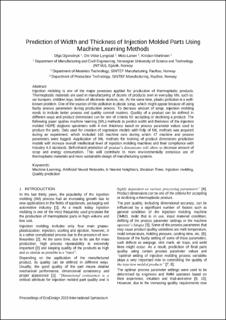| dc.contributor.author | Ogorodnyk, Olga | |
| dc.contributor.author | Lyngstad, Ole Vidar | |
| dc.contributor.author | Larsen, Mats | |
| dc.contributor.author | Martinsen, Kristian | |
| dc.date.accessioned | 2021-02-26T07:29:01Z | |
| dc.date.available | 2021-02-26T07:29:01Z | |
| dc.date.created | 2021-01-14T14:49:45Z | |
| dc.date.issued | 2021 | |
| dc.identifier.isbn | 978-981-15-6779-7 | |
| dc.identifier.uri | https://hdl.handle.net/11250/2730534 | |
| dc.description.abstract | Injection molding is one of the major processes applied for production of thermoplastic products. Thermoplastic materials are used in manufacturing of dozens of products seen in everyday life, such as: car bumpers, children toys, bodies of electronic devices, etc. At the same time, plastic pollution is a well-known problem. One of the sources of this pollution is plastic scrap, which might appear because of using faulty process parameters during production process. To decrease amount of scrap, injection molding needs to include better process and quality control routines. Quality of a product can be defined in different ways and product dimensions can be one of criteria for accepting or declining a product. The following paper applies machine learning (ML) methods to predict width and thickness of the injection molded HDPE dogbone specimens with 4 mm thickness based on process parameter values used to produce the parts. Data used for creation of regression models with help of ML methods was acquired during an experiment, which included 160 machine runs during which 47 machine and process parameters were logged. Application of ML methods for training of product dimensions prediction models will increase overall intelligence level of injection molding machines and their compliance with Industry 4.0 standards. Beforehand prediction of product’s dimensions will allow to decrease amount of scrap and energy consumption. This will contribute to more environmentally conscious use of thermoplastic materials and more sustainable design of manufacturing systems. | en_US |
| dc.language.iso | eng | en_US |
| dc.publisher | Springer | en_US |
| dc.relation.ispartof | EcoDesign and Sustainability I | |
| dc.title | Prediction of Width and Thickness of Injection Molded Parts Using Machine Learning Methods | en_US |
| dc.type | Chapter | en_US |
| dc.description.version | acceptedVersion | en_US |
| dc.source.pagenumber | 455-469 | en_US |
| dc.identifier.doi | 10.1007/978-981-15-6779-7_32 | |
| dc.identifier.cristin | 1871447 | |
| dc.relation.project | Norges forskningsråd: 256819 | en_US |
| dc.relation.project | Norges forskningsråd: 237900 | en_US |
| dc.description.localcode | "This is a post-peer-review, pre-copyedit version of an article. Locked until 3.11.2021 due to copyright restrictions. The final authenticated version is available online at: DOI " | en_US |
| cristin.ispublished | true | |
| cristin.fulltext | postprint | |
| cristin.qualitycode | 1 | |
